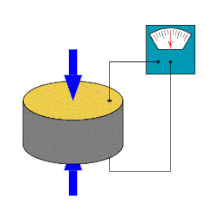Piezo element
A piezo element is a component that uses the piezo effect to either perform a mechanical movement by applying an electrical voltage ( piezo actuator , uses the so-called inverse piezo effect), or to produce an electrical voltage when a mechanical force is applied .
Materials
Piezoelectric elements can certain crystals ( piezoelectric crystals ), or piezoelectric ceramics , that polycrystalline materials can be. Mainly for the application as an actuator , ceramics are mostly used today, because at lower voltages they result in a greater change in length than piezo crystals; the most frequently used material is lead zirconate titanate (PZT). This material is ferroelectric and is polarized by heating it above the ferroelectric Curie temperature (at PZT approx. 300 ° C) and subsequent cooling in an electric field. As a result, the initially randomly aligned magnetic dipole moments ( Weiss areas ) are largely aligned in parallel.
The polarization can be destroyed by too high a temperature (close to the Curie temperature), too high a pressure or too high an electric field. The polarization described above must then be carried out again.
In comparison to piezo crystals, however, piezoelectric ceramics also have disadvantages:
- Higher non-linearity : the deflection is not exactly proportional to the applied voltage.
- Hysteresis : After applying and switching off an electrical voltage, the component does not return exactly to its original position
- Creep : The deflection does not immediately reach the end value when a constant voltage is applied.
Structure of piezo elements
Electrodes are applied to the piezoelectric material so that the applied voltage creates an electric field , or the electric field created by a mechanical force causes a voltage to be applied to the electrodes.
In the simplest case, a piezo element is a plate with electrodes on the end faces, which expands in the direction of thickness and contracts in the transverse direction when a voltage is applied. The deformation persists as long as the voltage is applied. If there are no changing external forces, no energy is required to maintain the deformation. If the polarity of the voltage is reversed, the direction of the deformation changes - in this case, contraction in the thickness direction and expansion in the transverse direction.
Other designs are piezoelectric tubes (electrodes on the inner and outer wall) and bending elements (also called bimorphs), in which two plates with an electrode in between are glued together so that when a voltage is applied, one expands and the other contracts at the same time. This leads to a bend similar to that of a bimetal strip , but the deformation is much less.
Piezo stack
Stack arrangements are used as an actuator or as a generator .
Piezo actuator

For use as a piezo actuator, the greatest possible movement amplitudes at low voltages are often desired. Since the relative longitudinal extent is proportional to the electric field strength, this can be achieved by keeping the electrodes small (field strength = voltage / electrode spacing). In the case of multilayer piezo elements (also known as “multilayer elements”, “piezo stack” or “piezo stack”), this is achieved by cascading several thin piezo elements with electrodes in between. This results in a mechanical series arrangement with control by an electrical parallel connection . The following scheme is used for this purpose: First you stack a piezo disk on an electrode (for example the plus connection), then another electrode (-) and finally another piezo disk, but this time the polarization direction is changed. This arrangement can now be repeated almost at will. The plus and minus electrodes are each connected on the outside. The arrangement of the electrodes can be thought of as combs that are nested so that the prongs of one comb fill the spaces between the other.
A voltage can now be applied to the electrode, so that the distance between the two electrodes increases due to a linear expansion of the piezocrystal. The maximum voltage to be applied depends on the thickness of the piezocrystalline disk, the material and the insulating properties between the electrodes. With a layer thickness of the piezo material of 0.2 mm, a maximum voltage of approximately 100–150 V can be applied. The maximum deflection is approximately 0.2%.
Since the electrodes are usually close to one another and the voltages are high, sparks can jump over the edges depending on the external conditions ( humidity , air pressure ). For this reason, the piezo stacks are insulated from the outside with a plastic . The requirements placed on this insulation are high and, until recently, was one of the most common reasons for the short life of piezo stacks. Piezo stacks with a ceramic coating have now also been developed.
Piezo generator
A piezo stack can also be used as a current or voltage source to generate higher currents or higher voltages . For this purpose, the elements are connected electrically in parallel or in series and the voltage generated is applied to a squib, for example, or the current generated is fed into a charging circuit .
See also
Web links
- Piezo tutorial
- Piezo theory
- piezotransfer - The platform for bundled knowledge of the piezoceramic industry
